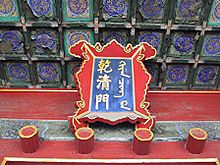You can help expand this article with text translated from the corresponding article in Chinese. (November 2015) Click [show] for important translation instructions.
|
| Manchu script ᠮᠠᠨᠵᡠ ᡥᡝᡵᡤᡝᠨ manju hergen | |
|---|---|
 18th-century manuscript | |
| Script type | |
| Languages | Manchu Xibe |
| Related scripts | |
Parent systems | |
Child systems | |
| ISO 15924 | |
| ISO 15924 | Mong (145), Mongolian |
| Unicode | |
Unicode alias | Mongolian |


| Transliteration of Chinese |
|---|
| Mandarin |
| Wu |
| Yue |
| Min |
| Gan |
| Hakka |
| Xiang |
| Polylectal |
| See also |
The Manchu alphabet (Manchu: ᠮᠠᠨᠵᡠ ᡥᡝᡵᡤᡝᠨ, Möllendorff: manju hergen, Abkai: manju hergen) is the alphabet used to write the now critically endangered Manchu language. A similar script called Xibe script is used today by the Xibe people, whose language is considered either a dialect of Manchu or a closely related, mutually intelligible language. It is written vertically from top to bottom, with columns proceeding from left to right.
- ^ a b Wilbourne, Emily; Cusick, Suzanne G. (2021-01-19). Acoustemologies in Contact: Sounding Subjects and Modes of Listening in Early Modernity. Open Book Publishers. ISBN 978-1-80064-038-2.
Manchu: its alphabet developed in 1599 from the Mongolian alphabet, which can be traced through Old Uyghur, Aramaic, and Syriac scripts all the way back to Phoenician, the fountainhead of all alphabets.
- ^ Houston, Stephen D. (2004-12-09). The First Writing: Script Invention as History and Process. Cambridge University Press. p. 59. ISBN 978-0-521-83861-0.
The Aramaic Uyghur script, which was likewise largely alphabetized, inspired the Mongolian alphabet and it in turn provided the basis for the Manchu alphabet created in AD 1599.